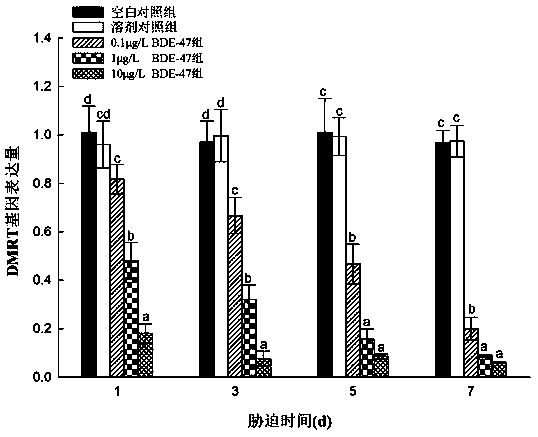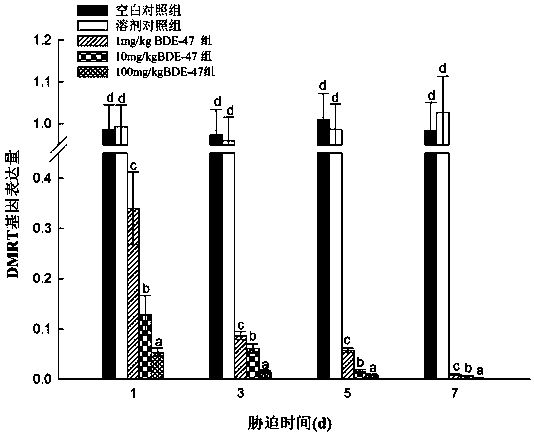A method for detection of PBDEs in the ocean using the DMRT gene of the four-cornered clam
A four-cornered clam, gene detection technology, applied in biochemical equipment and methods, DNA/RNA fragments, recombinant DNA technology, etc., can solve the problems of small distribution of mussels and oysters, achieve short detection time, reduce pollution, and method sensitive effect
- Summary
- Abstract
- Description
- Claims
- Application Information
AI Technical Summary
Problems solved by technology
Method used
Image
Examples
Embodiment 1
[0039] 1. Domestication of experimental organisms
[0040] Two-year-old male clams were used as experimental organisms, domesticated in laboratory glass tanks for 14 days, the water temperature was 16±1°C, the dissolved oxygen was 7.7-8.3, the pH was 7.9-8.1, and the salinity was 33. Change the water every day, and feed Nitzschia crescentus before changing the water.
[0041] 2. Conduct stress experiment
[0042] Four-cornered clams were transferred to 15 small glass tanks to start the experiment, each small tank was filled with 50L seawater, and 100 four-cornered clams were put in a suitable place to breed.
[0043] A total of 5 experimental groups were set up:
[0044] (1) Non-polluted natural seawater control group;
[0045] (2) dimethyl sulfoxide control group;
[0046] (3) 0.1μg / L tetrabromodiphenyl ether (BDE-47) group;
[0047] (4) 1.0μg / L tetrabromodiphenyl ether (BDE-47) group;
[0048] (5) 10μg / L tetrabromodiphenyl ether (BDE-47) group.
[0049] in:
[0050] ...
Embodiment 2
[0094] 1. Domestication of experimental organisms
[0095] Using two-year-old male clams as experimental organisms, the same method as in Example 1 was used to domesticate two-year-old male clams.
[0096] 2. Preparation of marine sediment
[0097] The clean surface 50mm sediment without PBDEs pollution was collected in the intertidal zone of Yantai, and transferred to the laboratory within 30 minutes after collection. Stir the sediment, pass through a 0.5mm nylon sieve, collect the sediment with a particle size of less than 0.5mm, and then stir evenly to achieve homogenization.
[0098] 3. Sediment spiked with PBDEs
[0099] Prepare BDE-47 mother solution (100mg / 0.1mL) with dimethyl sulfoxide, add standard sediment, and set up 5 experimental groups:
[0100] (1) Blank control (only natural seawater without pollution);
[0101] (2) Solvent control group (DMSO and sediment are mixed according to the volume-to-weight ratio of 1:10000);
[0102] (3) 1mg / Kg dry weight tetrabr...
Embodiment 3
[0151] In order to verify the feasibility and accuracy of the method for detecting the PBDEs in the ocean provided by the present invention, we have collected four-cornered clams, seawater and marine sediment from the tidal flats in the west of Laizhou Bay, and have detected seawater and marine sediment with the method provided by the invention The PBDEs in the samples were compared with the results measured by gas chromatography-mass spectrometry.
[0152] In May 2018, we set up 8 survey stations in the tidal flats on the west coast of Laizhou Bay. The latitude and longitude of these 8 survey stations are shown in Table 1.
[0153] Table 1 Latitude and longitude of survey stations on the west coast of Laizhou Bay
[0154] Station number longitude latitude 1 119°17′6″ 37°40′ 2 119°10′ 37°39′ 3 119°0′ 37°38′ 4 118°57′ 37°32′ 5 118°58′ 37°22′ 6 119°59′ 37°16′ 7 119°4′ 37°15′ 8 119°11′ 37°8′
[0155] We collected ...
PUM
 Login to View More
Login to View More Abstract
Description
Claims
Application Information
 Login to View More
Login to View More - R&D
- Intellectual Property
- Life Sciences
- Materials
- Tech Scout
- Unparalleled Data Quality
- Higher Quality Content
- 60% Fewer Hallucinations
Browse by: Latest US Patents, China's latest patents, Technical Efficacy Thesaurus, Application Domain, Technology Topic, Popular Technical Reports.
© 2025 PatSnap. All rights reserved.Legal|Privacy policy|Modern Slavery Act Transparency Statement|Sitemap|About US| Contact US: help@patsnap.com



